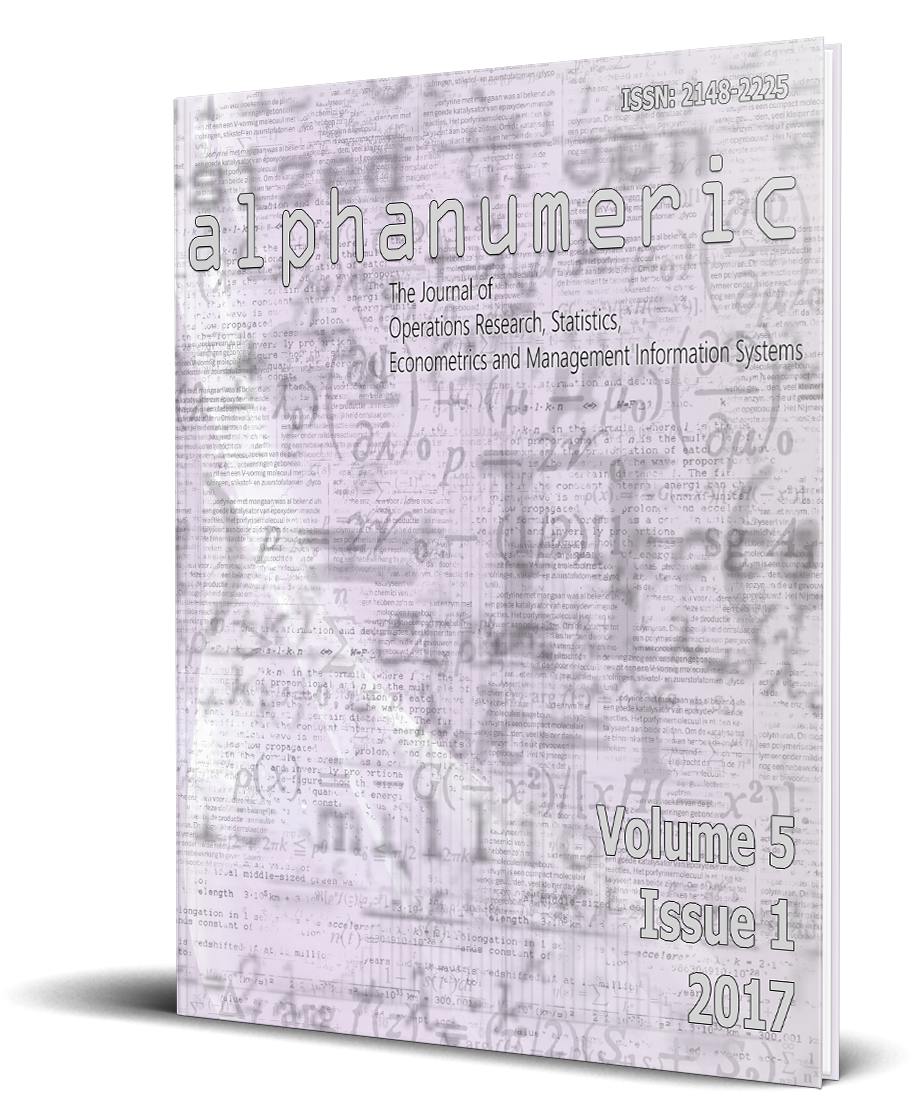
alphanumeric journal
The Journal of Operations Research, Statistics, Econometrics and Management Information Systems
Comparing Accuracy Performance of ELM, ARMA and ARMA-GARCH Model In Predicting Exchange Rate Return
Abstract
GARCH type models and artificial intelligence models are frequently used in the modeling of financial time series returns. In this study, the performance of ARMA and ARMA-GARCH models was compared with ELM. Four error measurement criteria were used in the performance comparison. According to the findings, ELM models of Euro and GBP exchange rates returns are superior to the ARMA and ARMA-GARCH models. According to this result, it can be said that ELM, one of the artificial intelligence-based methods, is more suitable for estimating the exchange rate returns during the period covered.
Keywords: ARMA, ARMA-GARCH, Artificial Neural Networks, Extreme Learning Machine
Döviz Kuru Getirisinin Tahmininde ELM, ARMA ve ARMA-GARCH Modellerinin Doğruluk Performansının Karşılaştırılması
Öz
Finansal zaman serilerinin getirilerinin modellenmesinde GARCH tipi modeller ve yapay zeka modelleri sıklıkla kullanılmaktadır. Bu çalışmada ARMA ve ARMA-GARCH modellerinin performansı, yapay zeka tekniklerinden ELM ile karşılaştırılmıştır. Performans karşılaştırmada dört adet hata ölçüm kriterinden yararlanılmıştır. Elde edilen bulgulara göre Euro ve GBP döviz kurlarının ELM modellerinin, ARMA ve ARMA-GARCH modellerine kıyasla daha üstün olduğu görülmüştür. Bu sonuca göre ele alınan dönem içerisinde, döviz kuru getirilerinin tahmininde ELM’ nin daha uygun olduğu söylenebilir.
Anahtar Kelimeler: ARMA, ARMA-GARCH, ELM (Hızlı Öğrenen Makina), Yapay Sinir Ağları
Suggested citation
(). Döviz Kuru Getirisinin Tahmininde ELM, ARMA ve ARMA-GARCH Modellerinin Doğruluk Performansının Karşılaştırılması. Alphanumeric Journal, 5(1), 1-14. http://dx.doi.org/10.17093/alphanumeric.298658
References
- Abdalla, S. Z. S. (2012). Modelling Exchange Rate Volatility using GARCH Models: Empirical Evidence from Arab Countries. International Journal of Economics and Finance, 4(3), 1206–1214.
- Bollerslev, T. (1986). Generalized autoregressive conditional heteroskedasticity. Journal of Econometrics, 31(3), 307–327.
- Box, G. E. P., Jenkins, G. M., Reinsel, G. C., & Ljung, G. M. (1976). Time Series Analysis: Forecasting and Control. San Francisco: Holdenday.
- Campbell, J. Y., Lo, A. W.-C., MacKinlay, A. C., & others. (1997). The Econometrics of Financial Markets (Vol. 2). princeton University press Princeton, NJ.
- Cao, L., & Tay, F. E. H. (2001). Financial Forecasting Using Support Vector Machines. Neural Computing & Applications, 10, 184–202.
- Çil Yavuz, N. (2015). Finansal Ekonometri (2nd ed.). İstanbul: Der Yayınları.
- Enders, W. (2010). Applied Econometric Time Series (3rd ed.). John Wiley & Sons.
- Engle, R. F. (1982). Autoregressive Conditional Heteroscedasticity with Estimates of the Variance of United Kingdom Inflation. Econometrica, 50(4), 987–1007.
- Hamilton, J. D. (1994). Time series analysis (Vol. 2). Princeton University press Princeton.
- Haykin, S. (2009), Neural Networks and Learning Machines, Third Edition, New York, Pearson Prentice Hall.
- Hossain, A., & Nasser, M. (2011). Comparison of the finite mixture of ARMA-GARCH, back propagation neural networks and support-vector machines in forecasting financial returns. Journal of Applied Statistics, 38(3), 533–551.
- Huang, G.-B., & Babri, H. A. (1998). Upper bounds on the number of hidden neurons in feedforward networks with arbitrary bounded nonlinear activation functions. IEEE Transactions on Neural Networks, 9(1), 224–229.
- Huang, G.-B., Zhu, Q.-Y., & Siew, C.-K. (2004). Extreme learning machine: a new learning scheme of feedforward neural networks. In 2004 IEEE International Joint Conference on Neural Networks (IEEE Cat. No.04CH37541) (Vol. 2, pp. 985–990 vol.2).
- Huang, G.-B., Zhu, Q.-Y., & Siew, C.-K. (2006). Extreme learning machine: Theory and applications. Neurocomputing, 70(1), 489–501.
- Huang, W., Lai, K. K., Nakamori, Y., & Wang, S. (2004). Forecasting Foreign Exchange Rates with Artificial Neural Networks - A Review. International Journal of Information Technology & Decision Making, 3(1), 145–165.
- Judge, G. G., Hill, R. C., Griffiths, W., Lutkepohl, H., & Lee, T. C. (1988). Introduction to the Theory and Practice of Econometrics.
- McCulloch, W. S., & Pitts, W. (1943). A logical calculus of the ideas immanent in nervous activity. The Bulletin of Mathematical Biophysics, 5(4), 115–133.
- Nelson, D. B., & Cao, C. Q. (1992). Inequality Constraints in the Univariate GARCH Model. Journal of Business & Economic Statistics, 10(2), 229–235.
- Öztemel, E. (2006). Yapay Sinir Ağları (3. Baskı). İstanbul: Papatya Yayıncılık.
- Package, T., Gosso, A. A., & Training, D. (2015). Package “ elmNN .”
- Pham, H. T., & Yang, B. S. (2010). Estimation and forecasting of machine health condition using ARMA/GARCH model. Mechanical Systems and Signal Processing, 24(2), 546–558.
- Tay, F. E., & Cao, L. (2001). Application of support vector machines in financial time series forecasting. Omega, 29(4), 309–317.
- Vilasuso, J. (2002). Forecasting Exchange Rate Volatility. Economics Letters, 76, 59–64.
- West, P. M., Brockett, P. L., & Golden, L. L. (1997). A Comparative Analysis of Neural Networks and Statistical Methods for Predicting Consumer Choice. Marketing Science, 16(4), 370–391.
2017.05.01.ECON.01
alphanumeric journal
Pages 1-14
Received: March 20, 2017
Accepted: April 19, 2017
Published: June 30, 2017
2017 Esenyel İçen, NM., Akın, M.
This is an Open Access article, licensed under Creative Commons Attribution-NonCommercial 4.0 International License.

scan QR code to access this article from your mobile device
Contact Us
Faculty of Transportation and Logistics, Istanbul University
Beyazit
Campus 34452 Fatih/Istanbul/Türkiye
Bahadır Fatih Yıldırım, Ph.D.
editor@alphanumericjournal.com
+ 90
(212) 440 00 00 - 13219
alphanumeric journal
alphanumeric journal has been publishing as "International Peer-Reviewed Journal" every six months since 2013. alphanumeric serves as a vehicle for researchers and practitioners in the field of quantitative methods, and is enabling a process of sharing in all fields related to the operations research, statistics, econometrics and management informations systems in order to enhance the quality on a globe scale.

